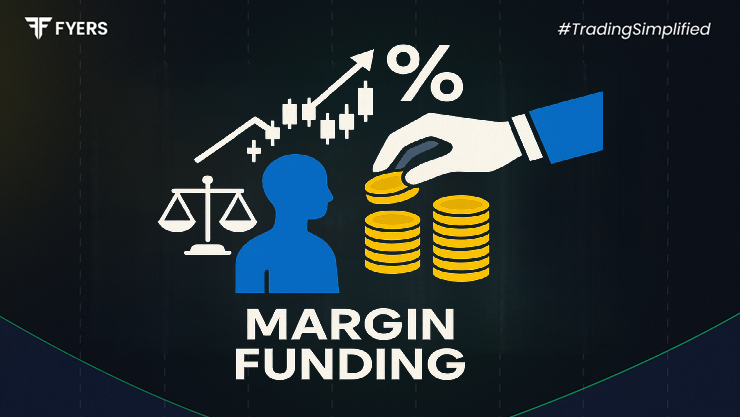

 24 Sep, 2025
24 Sep, 2025
 4 mins read
4 mins read

Trading in the stock market often requires substantial capital. But not every investor or trader has enough funds readily available. This is where margin funding comes in. It allows investors to borrow money from brokers to purchase shares, enabling them to take larger positions than their available capital would normally allow.
In this guide, we will explain what is margin funding, how margin accounts work, IPO margin funding, along with its benefits, risks, and an example.
Margin funding is a facility provided by stockbrokers that allows traders and investors to borrow funds to buy securities. Instead of paying the entire amount upfront, the investor pays a part of it (margin), and the broker funds the rest.
This mechanism helps investors take advantage of opportunities without having to liquidate existing holdings or wait to arrange capital. It is commonly used for short-term trading strategies but also applies in IPO investments.
To use margin funding, an investor needs a margin account with their broker.
A margin account is a trading account that allows investors to borrow money from the broker to buy shares. Unlike a normal trading account, it involves both the investor’s contribution (margin) and the broker’s loan.
Investor deposits a certain margin amount.
Broker lends additional funds to increase buying power.
Purchased securities act as collateral for the borrowed funds.
Investor pays interest on the borrowed amount until repayment.
This process is also known as margin trade funding (MTF) in India.
In India, margin trade funding is regulated by SEBI (Securities and Exchange Board of India). Key points include:
Brokers specify eligible stocks for margin funding.
Investors must maintain a minimum margin requirement (often 25% or more).
Brokers charge interest on the borrowed funds, usually on a daily basis.
Securities purchased through margin are held in the broker’s beneficiary account until repayment.
Failure to maintain adequate margin can lead to a margin call, where the broker may ask the investor to deposit more funds or sell securities to cover the shortfall.
IPO margin funding allows investors to apply for an Initial Public Offering (IPO) by borrowing money from their broker.
Instead of paying the full application amount, the investor contributes only a margin.
The broker funds the remaining amount and applies on behalf of the investor.
Once shares are allotted, the investor must repay the funded portion along with interest.
This facility enables investors to apply for a larger number of shares than they could with their own capital.
Let’s consider an example:
An investor wants to buy shares worth ₹1,00,000.
The broker allows margin funding with a 40% margin requirement.
The investor contributes ₹40,000, while the broker funds ₹60,000.
The investor pays interest (say 12% annually, calculated daily) on the borrowed ₹60,000 until repayment.
If the share price rises, profits are magnified. However, if the share price falls, losses are also amplified, making it a high-risk, high-reward strategy.
Increased Buying Power – Helps investors take larger positions with limited capital.
Flexibility – No need to liquidate existing holdings to fund new trades.
Opportunity in IPOs – Enables higher applications in IPOs through margin financing.
Short-Term Leverage – Useful for traders who rely on quick market movements.
Despite its advantages, margin funding in stock trading comes with risks:
Amplified Losses – Losses are magnified, just like profits.
Interest Costs – Daily interest charges can reduce overall returns.
Margin Calls – Investors may be forced to deposit more money or sell holdings.
Market Volatility – Sudden price movements can lead to quick losses.
Hence, margin funding should be used cautiously, and only by those who understand market risks.
Margin funding is a powerful tool that enhances an investor’s purchasing capacity by allowing them to borrow funds from their broker. From regular stock purchases to IPO margin funding, it provides flexibility and access to larger opportunities.
However, it carries significant risks due to leveraged exposure and interest costs. Therefore, margin trade funding is best suited for experienced traders who can manage risks effectively. Beginners should start small and always be mindful of margin requirements and interest implications.
Margin funding is a facility where brokers lend money to investors so they can buy more shares than their own capital allows.
A margin account is a type of trading account that lets investors borrow money from brokers to purchase securities, with those securities acting as collateral.
In IPO margin funding, the investor pays a partial margin amount while the broker funds the rest for IPO applications. The investor repays the borrowed funds with interest once shares are allotted.
Calculate your Net P&L after deducting all the charges like Tax, Brokerage, etc.
Find your required margin.
Calculate the average price you paid for a stock and determine your total cost.
Estimate your investment growth. Calculate potential returns on one-time investments.
Forecast your investment returns. Understand potential growth with regular contributions.